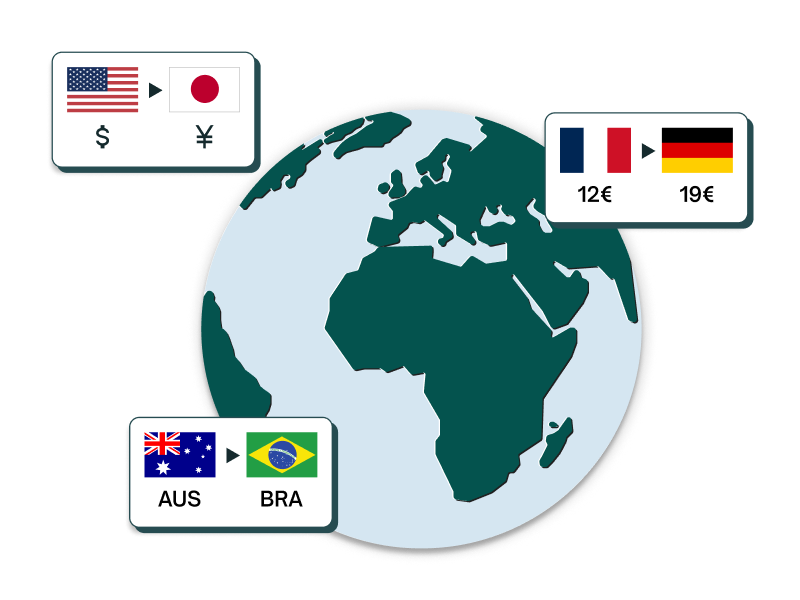When and How to Manage Multiple Shopify Stores
While Shopify Markets offers various advantages, in 2024, specific situations still lead brands to choose managing multiple stores. Explore when, how, and the best practices for opening multiple stores on Shopify.

Until recently, customizing shopping experiences for different countries, adjusting prices, products, currencies, and content for each region, seemed like a complex task. The only viable option was creating multiple expansion stores, each designed from scratch.
However, this solution had evident drawbacks. Duplicating operations resulted in significant associated costs, and only a considerable volume of sales in a market would justify the brand's investment. Managing multiple stores became both an operational and financial challenge.
In August 2021, Shopify took a step forward to revolutionize international expansion with the launch of Shopify Markets, a set of tools designed to address the needs of brands expanding globally.
With the evolution of Shopify Markets, the need for multiple expansion stores for customizing shopping experiences lost relevance. The simplicity and speed with which localized experiences can be designed with Shopify Markets have transformed the landscape. This process is detailed in our free course on Shopify Markets, and we invite you to register for more in-depth information.
Despite the advantages of Shopify Markets, in 2024, specific situations still lead brands to choose managing multiple stores in Shopify. This article aims to explore when it might be necessary to resort to an expansion store, how to open multiple stores on Shopify without requiring a Shopify Plus plan, and provide answers to frequently asked questions, along with best practices for efficiently managing multiple stores.
Shopify Plus Expansion Stores vs Multiple Shopify Stores
How Many Shopify Stores Can I Have?
With Shopify Plus from Shopify, you have the ability to create up to 10 Expansion Stores within a single Shopify account. What does this mean? Essentially, brands can, in just a few clicks, set up a new Expansion Store to enter other markets. This process involves duplicating the main store, greatly simplifying the launch and opening of the new store.
However, there are situations where brands might prefer to create different Expansion Stores for different markets without the need for a Shopify Plus store. It's important to note that a brand can also manage multiple stores on Shopify, albeit with some differences. In this case, the brand will need to purchase different Shopify plans, one for each store. For example, it could have a basic plan for one store and an advanced Shopify plan for another. Additionally, each store will have unique credentials, and creating it will involve starting from scratch, without the ability to duplicate an existing store. This means more tasks and development hours for the launch of each store.
How Much Does It Cost to Have Multiple Shopify Stores?
The Shopify Plus plan provides the flexibility to set up to ten stores under a unified pricing structure, with the specific cost negotiated between Shopify and the brand. On the other hand, choosing multiple Shopify Stores, each with different plans, like the Advanced Plan at 348€/month and the Basic Plan at 36€/month (prices may vary by country), introduces additional considerations.
Moreover, brands should factor in the variable costs associated with the applications required to manage daily operations.
When Having Multiple Shopify Stores is the Right Decision?
As we've seen, having multiple stores on Shopify is not limited to Shopify Plus plans. Regardless of your plan, you can achieve it one way or another. However, since 2023, some reasons no longer make sense with Shopify Markets.
If you want to customize products, prices, languages, or content for each market, then Shopify Markets is sufficient and the most optimal choice for any store. Below, we explain when managing multiple Shopify stores might still make sense.
Keep in mind that Shopify Markets is growing and improving rapidly. Some reasons for creating a new store on Shopify may no longer be relevant in a few months or years. Creating a new store involves duplicating operational costs, so, in some cases and depending on the brand's situation, waiting for Shopify Markets to improve may be the best long-term option.
Your Brand Has Different Companies in Different Countries
Currently, Shopify only allows linking one company with each store. Therefore, brands that want to invoice their sales from different countries with different companies inevitably have to have multiple stores on Shopify.
Another Company Is Exploiting My Brand in a Specific Country
This is a variation of the previous case, but have you reached an agreement with a company in a country to have exclusive distribution rights there? In that case, it will be inevitable to have different stores. Firstly, because different entities will invoice sales from different countries. Secondly, because the distributing company has an independent team that won't have access to the brand's account. Additionally, the distributing company will have limited products and a different pricing strategy.
Shopify Payments Is Not Available in My Country
Shopify Markets allows brands to activate payments in the local currency with just one click, provided that Shopify Payments is available in the brand's home country. If not, this coveted functionality is unavailable. That's why some brands, when opting for international expansion, choose to establish a legal entity in a country where Shopify Payments is available, as this allows them to activate local currencies.
For example, consider an Argentine brand with a significant user base in Spain looking to enhance localization. To achieve this, they want to sell in Euros in Spain and expand sales throughout Europe. To do so, they establish the company in Spain and open a new store. Then, they can already activate local currencies.
Orders are fulfilled from different warehouses depending on the destination country
Although it seems that this issue will be resolved within Shopify Markets throughout 2024, currently, when a brand connects multiple warehouses, the stock is accumulated, and rules cannot be created to display different stock levels for the same product depending on the destination country.
For instance, imagine you have a warehouse in the United States and another in Spain. Your brand sells only in the United States and Europe. For the United States, deliveries are made from the US warehouse, while for all European countries, deliveries are made from the warehouse in Spain. The reason for this decision is that delivering from Spain to the United States would incur much higher shipping costs that would eat into the margin, as well as additional customs costs.
In this situation, on the product detail page, European users should see the stock from the warehouse in Spain, while Americans should see the stock from the US warehouse. At the time of writing this article, this situation is not possible, and Shopify displays the accumulated stock from both warehouses in all countries, resulting in the aforementioned problems.
High Volume of Orders in Countries with Different Currencies
In 2024, Shopify still processes payments only in the main currency of the store. In countries where Shopify Payments is available, Shopify allows receiving payments in the local currency, but ultimately, payments to the brand are made in the main currency of the store, applying a currency exchange fee. That is, if the main currency of the store is Euros, then it will be paid in euros even if the brand sells in the United States, and those users can pay in USD.
Continuing with this example, in the case of having a high volume of sales in the United States, the brand has incentives to create a new Expansion Store with USD as the main currency to avoid additional currency exchange fees.
Having an Exclusive Store for a Region or State
Imagine that your brand wants to offer different products or prices in Puerto Rico or the Canary Islands (Spain). Currently, Shopify Markets does not allow the creation of markets for a territory that does not have the status of a country. If that's the case, then to create a market for different exclusive territories or states within a country, you'll have to create a new Shopify store.
Best practices when you have multiple Shopify stores
When it comes to managing multiple stores on Shopify, it's essential to know the best practices or apps that will make our lives easier. Below, we show you some best practices and which apps are a must.
Geolocation
Orbe is an advanced geolocation application for Shopify that syncs with Shopify Markets and allows you to connect multiple Expansion Stores to redirect users to the appropriate shopping experience based on their location and preferences. Whether you have Shopify Plus Expansion stores, multiple Shopify Stores, or even Expansion Stores on platforms outside of Shopify, you can direct users to the right experience.
Hreflang Manager
When managing different stores for the same brand, it's important to signal to Google which store is the correct one for each country to improve your SEO ranking. In case you have the same URL structure across your multiple stores, you can use Orbe's Hreflang Manager included in the Plus plan, which allows you to connect multiple geolocated stores to redirect the user to the correct experience based on their location.
However, if you have a different URL structure for each store, you can use a more advanced option of the Hreflang Manager that allows you to configure more sophisticated relationships at the product level.
Multifeeds for Google Shopping
At times, we have seen how some brands have created multiple stores on Shopify to send different product feeds to Google Shopping based on the country. If this is the main reason for creating multiple stores, then we encourage you not to do so. However, if you manage multiple Shopify stores for other reasons, then Multifeeds for Google Shopping will help you manage the feeds you send to Google Shopping or different marketplaces.
Multistore Sync
When you manage multiple expansion stores and fulfill orders from the same warehouses, it's crucial to ensure that inventory, products, and collections stay synchronized automatically in real-time. This is especially important when new orders, refunds, cancellations, or restocks occur. Multi-Store Sync Power is a tool designed to streamline these tasks and maintain consistency across your various stores.

